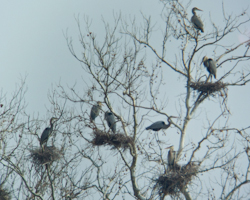Vol. 13 Issue 1, Spring 2008
By Kerry Bzdyk

Photo by Spring Ligi
Loudoun County is home to a great diversity of bird species, from small beautiful songbirds to large and striking raptors, but one of our more majestic and easily identifiable permanent residents is the Great Blue Heron. Just about everyone has a memory of seeing one of these elegant birds poised over a pond or wetland in the early morning, motionless and hunting for a meal. It is always a thrill to see them.
The Great Blue Heron is a large grayish-blue bird, standing about four feet high, with long legs and a long curved neck. It has a thick, pointed beak, a white stripe on the crown of the head and a black stripe that begins behind the eye and extends to the back of the head. The feathers on the wings and back can look rather shaggy or hairy. The males and females of this species look alike. They are striking to see in flight as well, with their long legs extended out behind them and their six-foot wingspan.
Great Blue Herons are found all over the United States and southern Canada, and a white form of the bird ranges from southern Florida and into the Caribbean. They are most often found near bodies of water or wetlands, where they eat a variety of fish, frogs, salamanders, and even rodents and insects. Nesting pairs bond in the spring, and nests are built in trees close to food sources so that the young will be well fed.

Photo by Nicole Hamilton
Although pairs will occasionally nest singly, most Great Blue Herons nest in large colonies called rookeries. The nests are constructed of sticks and may be used in subsequent years if they remain intact. Three to seven eggs are laid in March or April and are incubated for 28 days. The young are fed mostly regurgitated food in their early days, but graduate to a diet of whole fish dropped into their beaks. The young leave the nest in about 60 days and may live for up to 15 years.
More than half of the East Coast’s breeding population of Great Blue Herons live near the Chesapeake Bay or its tributaries. Loudoun County, with its abundance of streams, ponds, and wetlands areas, has always been home to Great Blue Herons, and their numbers are strong here.
You can observe a thriving island rookery nearby by looking south as you cross on White’s Ferry (best seen in early to mid-spring before the leaf cover hides the large treetop nests). There is another Great Blue Heron Rookery located in Ashburn which you can view from the road. But as with many species, loss of habitat is the greatest threat to their continued coexistence with us. If we continue to work to preserve wetlands, and to support organizations that monitor and protect these habitats, we will be able to look upon these gracious birds for many generations to come.
Resources:
https://www.fws.gov/chesapeakebay/heron.html
http://www.birds.cornell.edu/AllAboutBirds/BirdGuide/Great_Blue_Heron.html

